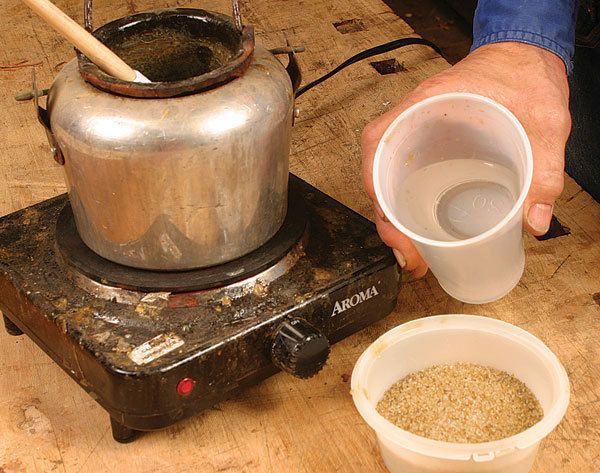Hide Glue: A Closer Look
Age-old technology has unmatched advantages: It’s quick-setting, transparent to finishes, easy to clean up, and reversible
Synopsis: It may be your grandfather’s glue, but that doesn’t mean that hide glue has lost its place in the modern wood shop. The traditional glue pot has fallen out of the spotlight in the past few decades, overshadowed by new types of adhesives. Yet it has many advantages over synthetic glue. It sets quickly, is transparent to oils, stains, and finishes, is easy to clean up, and is easily reversible when repairs are needed (just apply heat and moisture). Animal protein glues are also organic in nature, and are not harmful to people or pets. Patrick Edwards swears by hide glue for almost all his furniture making needs. With the information he supplies here, you’ll soon join him as a hide-glue convert.
If you were lucky enough to learn woodworking from your grandfather, he would have patiently shown you which end of a handplane is the front, the right way to use a chisel (not for opening paint cans), and how to cook glue. Unfortunately, the traditional glue pot disappeared from woodshops and trade schools soon after World War I when synthetic adhesives took over, leaving later generations of woodworkers to learn this secret of the craft on their own.
Hot animal-protein glues have many advantages over synthetics. They are very quick-setting; transparent to stains, oils, and other finishes; easy to clean up; and reversible, making repairs possible. They are also organic in nature, and are not toxic to humans or pets.
If you doubt the strength of animal glue, check out the recent test in FWW #192 (“How Strong Is Your glue?”), where hide glue stood shoulder-to-shoulder with yellow glues and epoxies. And of course, witness the host of antique furniture that has survived for hundreds of years.
All wood glues create a mechanical bond by penetrating the porous surface and solidifying there. But animal glues also create a strong molecular bond with wood (and other animal glues), due to the attraction between certain molecules and atoms.
The glue sets initially by losing heat, and then cures fully by losing moisture. As mentioned earlier, this process is always reversible, and can be repeated even after a century or more.
The right animal glue for you
Although there are many excellent organic glues—from fish, milk protein, rabbit skin, horse bone and hide, and vegetable compounds—I’ll focus on hide glue, the most versatile type for furniture making. Today, hide glues are sold either in pearl or granulated form; I recommend only the latter, which turns to gel very quickly when cold water is added.
Hide glue can vary in quality, and it can go bad if exposed to moisture. Some people have sworn off hide glue after buying poorly made or poorly stored animal glue from indiscriminate sources all around the world, and then experiencing joint failures. others complain about the smell. good quality glue has a very mild animal odor. If it smells rancid, it is bad and should be thrown out.
From Fine Woodworking #197
For the full article, download the PDF below:
Fine Woodworking Recommended Products

Jorgensen 6 inch Bar Clamp Set, 4 Pack

Festool Rotex FEQ-Plus Random Orbital Sander

3M Blue Tape






















Comments
I have now tried it and just love using it.Great article.
Log in or create an account to post a comment.
Sign up Log in